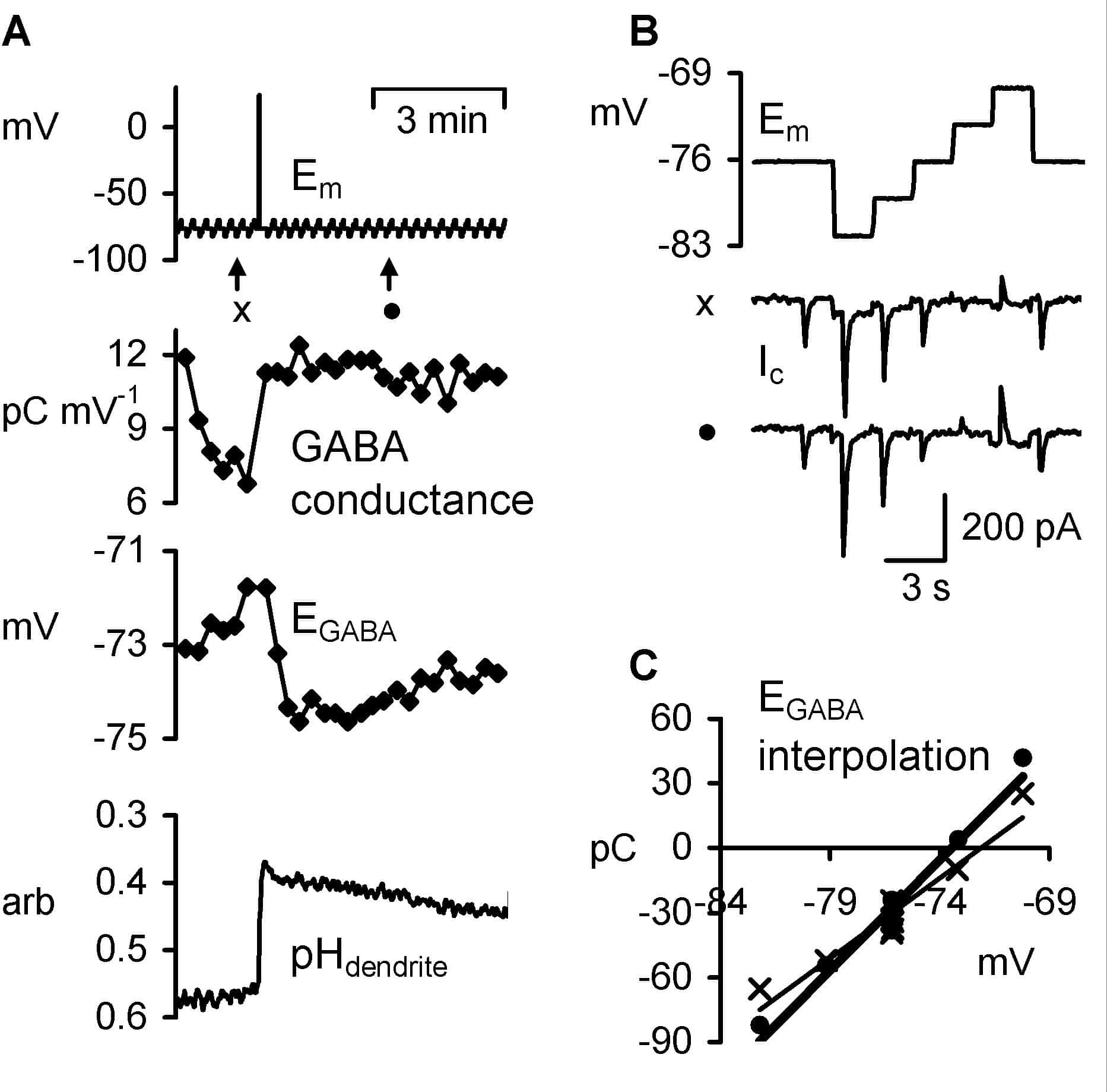It is well known that neuronal electrical activity is associated with shifts in intracellular pH (Ahmed & Connor, 1980). However, the absolute size of the pH changes and their importance is far from clear. Here we show one potentially important effect of activity-dependent pH changes on the GABA equilibrium potential (EGABA). Purkinje neurones, in rat cerebellar slices (200 µm), were whole-cell patch-clamped using pipettes containing both the pH-sensitive dye HPTS and the calcium-sensitive dye Fura-Red and imaged using a confocal microscope (Leica SP5). Using a second pipette GABA was applied (4 ms, 50-100 kPa) to the primary dendrite (~60 µm from soma). Figure 1A shows traces from a typical experiment. Em was repeatedly stepped through a range of potentials (see staircase in Fig 1B). At each potential GABA was applied and the resultant currents recorded. For each staircase, the integral of the currents was used to interpolate EGABA and calculate the GABA conductance. After a series of control recordings the neurone was depolarized (~80 mV for 1 s) and, after a short delay, the applications of GABA were resumed. In Fig 1A the large depolarization evoked an immediate increase in the GABA conductance and an intracellular acidification, recorded at the dendrite, as well as a delayed negative shift in EGABA. Not all cells showed this response. In ~67% of cells EGABA showed a larger and immediate positive shift consistent with chloride accumulation. The relationship between the GABA conductance shift presented here, and that described by Kano et al 1992 is unclear. We suspect that intracellular pH regulation might underlie the shift in EGABA through an alteration in local intracellular chloride (Kim & Trussell, 2009). This is supported by our observations that SITS application can modulate EGABA (-1.28±0.36 mV, mean±SEM, n=5). Such a hypothesis does not, however, appear consistent with the known mechanisms of intracellular pH regulation in cultured Purkinje neurones (Gaillard & Dupont, 1990).
University of Manchester (2010) Proc Physiol Soc 19, PC35
Poster Communications: Does intracellular pH regulation underlie the depolarization-evoked shift of the dendritic GABA reversal potential in rat cerebellar Purkinje neurones?
O. Larina1, C. J. Schwiening1
1. Department of Physiology, Development and Neuroscience, University of Cambridge, Cambridge, United Kingdom.
View other abstracts by:
Figure 1. Assessment of EGABA and its relationship to dendritic pH in a whole-cell patch clamped Purkinje neurone using a Cs-based pipette solution containing 4 mM Cl. A, Membrane potential (Em), GABA conductance, EGABA and dendritic pH (pHdendrite) before and after a large 1 s depolarization. B, Magnified view of the small staircase depolarizations and GABA-evoked currents before and after the large depolarization as indicated by x and â— in A. C, GABA-evoked currents before (x) and after (â—) depolarization were integrated and plotted against Em. EGABA was interpolated, and the conductance (slope) calculated, from least-squares linear fits. The thick line shows the increase in conductance and negative shift in EGABA evoked by the depolarization.
Where applicable, experiments conform with Society ethical requirements.

